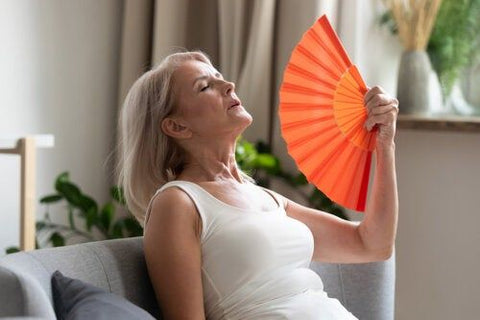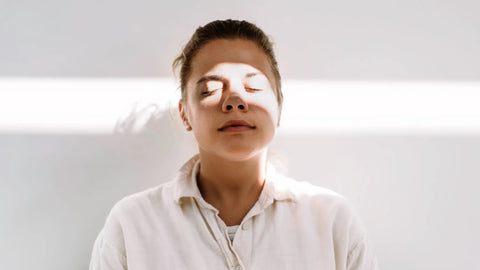Hot flashes are one of the most common symptoms of menopause , affecting 70-80% of women during this stage. They are characterized by a sensation of heat that affects mainly the upper part of the body, accompanied by sweating, chills, palpitations and skin redness. Although they do not represent a health risk in themselves, they can significantly alter the quality of life, interrupting sleep, affecting mood and making daily activities difficult.
What are they?
Hot flashes are like hot flashes. This happens because menopause is accompanied by hormonal instability that affects the regulation of body temperature, hence the sudden surges in heat known as hot flashes.
And why do hot flashes happen?
The cause of these hot flashes is found in the hypothalamus , since it is where the thermoregulatory center of our body is located, that is, the one responsible for regulating body temperature and due to the hormonal instability typical of menopause, this center becomes hyperactive and causes a sudden rise in body temperature.
But why do some women suffer more hot flashes than others?
It is always due to the conditions of each person's body and the particular situation, but there are risk factors and triggers for hot flashes:
Risk factors that increase the possibility of suffering from them:
- Obesity
- Surgical and unnatural menopause
- History of premenstrual syndrome
- Ethnicity. For example, black women report more hot flashes during menopause than Asian women.
And as triggering factors for these hot flashes we find:
- Tobacco
- Alcohol
- Heavy meals
- High ambient temperature or closed spaces
- Stress situations
Types of hot flashes during menopause:
-
Classic hot flashes: These are the most common form and are characterized by a wave of heat that runs through the body, accompanied by sweating, chills, palpitations and skin redness.
-
Nighttime hot flashes: These are very common and are called this because they occur while you are sleeping and can cause you to wake up sweating and shivering. These hot flashes can interrupt your sleep and make you feel tired during the day, which can worsen fatigue, headaches, lack of concentration... and other symptoms characteristic of menopause.
-
Localized hot flashes: These only affect one part of the body, commonly the face, chest, or hands. They occur for the same reason as vasomotor hot flashes, but some additional mechanisms that specifically affect the affected region, such as neurological factors, hormonal changes, or more specific medical conditions.
What are the most common symptoms?
Every woman experiences them differently. Some common symptoms are:
- Sudden sensation of heat in the upper body that spreads to the chest, neck and face
- Redness of the skin
- Rapid heart rate
- Sweating, mainly on the upper body
- Chills as the flushing subsides
- Dizziness
- Nausea
- And even, a feeling of anxiety
How long do menopausal hot flashes last?
The frequency and intensity of hot flashes varies among women. A single episode may last one or two minutes, up to 5 minutes or even 10 minutes.
Hot flashes can be mild or so severe that they disrupt daily activities.
This happens to around 80% of women during menopause and the symptom usually lasts between 1 and 3 years, but there are cases in which women suffer from it for more than 10 years.

Do menopausal hot flashes help you lose weight?
We regret to inform you that no, they do not lose weight. Because during a hot flash the only thing that is lost is water due to sweating caused by the increase in temperature caused by the hot flash itself. But this is not associated with fat loss and therefore no weight loss.
How can I relieve them?
There are women who experience hot flashes as an interruption in their daily activities and it is therefore important to know what to take for menopausal hot flashes:
Hormone replacement therapy (HRT):
HRT is a medical treatment that replaces the hormones that the body stops producing during menopause. This therapy can be administered in a variety of ways, including systemic pills and patches, or local vaginal gels and rings. HRT is an effective option for relieving the symptoms of menopause, especially hot flushes, vaginal dryness and sleep disturbances.
As an alternative for hot flashes during menopause, we find non-hormonal and natural treatments such as food supplements:
- Phytoestrogens: Some natural compounds, such as genistein, an isoflavone (found in soybeans) and hops, have phytoestrogenic properties. This means that they can mimic some of the effects of estrogen and therefore mitigate menopausal symptoms such as hot flashes that emerge after the levels of this hormone in our body drop.
- Cytoplasmic pollen extract: This natural compound has been shown to be effective in relieving hot flashes and other symptoms of menopause in several clinical studies. Unlike phytoestrogens, cytoplasmic pollen extract is also suitable for women who have a history of or have had breast cancer.
- Black cohosh: This medicinal herb has been traditionally used to relieve symptoms of menopause. Some clinical studies have shown that black cohosh may be effective in relieving hot flashes and other symptoms. It is also suitable for women diagnosed with breast cancer.
In addition to these therapeutic options, the most important thing to avoid having very aggressive hot flashes that affect the quality of life is to lead a healthy lifestyle in terms of eating habits, physical activity and a good sleep schedule, among others. In addition, reducing toxic habits such as tobacco and alcohol as much as possible.
Lifestyle modifications:
- Avoid triggers: Certain factors can trigger or worsen hot flashes, such as alcohol, caffeine, spicy foods, tobacco, and hot environments. Identifying and avoiding these triggers can help reduce the frequency and intensity of hot flashes. One tip: Try carrying a small, cool fan or handkerchief with you at all times to cool yourself down when you experience a hot flash.
- Maintaining a healthy weight: Being overweight can exacerbate the intensity of hot flashes. Losing weight can help relieve symptoms. Remember: It's not about crash dieting, but about adopting a healthy lifestyle with a balanced diet and regular exercise!
- Regular physical activity: Regular physical activity can help reduce the frequency and intensity of hot flashes, as well as improve overall health. Do you like to dance? Great! Dancing is a fun and effective way to exercise and combat hot flashes.
- Adequate sleep: Insomnia can make hot flashes worse. Ensuring 7 to 8 hours of sleep per night can help improve sleep quality and reduce the intensity of hot flashes. Create a sleep routine: Go to bed and wake up at the same time every day, even on weekends. Relax before bed with a warm bath or by reading a book.
- Relaxation techniques: Practicing techniques such as deep breathing, meditation, or yoga can help reduce stress and anxiety, which can help relieve hot flashes. Meditation apps: There are many mindfulness and meditation apps that can guide you through this process. Try them out and find the one that works best for you!
- Medications: If lifestyle changes aren't enough, your doctor may prescribe some treatment for menopausal hot flashes to help you manage them. Please note: It's important to consult with your doctor for advice on the best option for you, taking into account your medical history and other health conditions.
And our last piece of advice: Surround yourself with understanding and positive people. The support of your loved ones can be essential to face the changes of menopause with optimism and joy.
Remember, you're not alone! Hot flashes are a normal part of menopause, but there are many things you can do to feel better. Talk to your doctor about your options for managing them and enjoying this time of your life.
If you identify with any of the points in this blog or would like to know more about the topic → read the following blog and find out or take our test.
References:
- Hot flashes, an obvious and annoying symptom of menopause . (n.d.). Quirónsalud. Retrieved April 9, 2024, from https://www.quironsalud.com/es/comunicacion/actualidad/sofocos-sintoma-menopausia-evidente-molesto
- Hot Flashes: What Can I Do? (n.d.). National Institute on Aging. Retrieved April 9, 2024, from https://www.nia.nih.gov/menopause/hot-flashes-what-can-i-do
- GET READY FOR MENOPAUSE . (2019, September 5). Dr. Carolina Paladino. https://carolinapaladino.es/preparate-para-la-menopausia/
- Hot flashes during menopause: Causes, symptoms and strategies for their management . (n.d.). Blog of Teknon Medical Center. Retrieved on April 9, 2024, from https://www.teknon.es/blog/es/salud-az/sofocos-menopausia-causas-sintomas-estrategias-manejo
- Medtronic-HDO. (2023, December 6). Obesity and menopause: a dangerous combination. Talking about obesity . https://hablandodeobesidad.com/obesidad-y-menopausia-una-combinacion-peligrosa/
- Goya, M. (2023, December 16). Do these 5 simple exercises to stay active during menopause . El Español. https://www.elespanol.com/mujer/salud-bienestar/20231216/haz-sencillos-ejercicios-mantenerte-activa-menopausia/817418332_0.html
- Jaramago, J. (2022, January 24). Hormone replacement therapy or HRT in menopause. Dr. Jaramago . https://www.doctorajaramago.com/hormonal-replacement-therapy-menopause/
- A low dose of antidepressants can reduce the number of hot flashes during menopause . (2014, June 2). psychiatry.com. https://psiquiatria.com/treatments/a-low-dose-of-antidepressants-can-reduce-the-number-of-hot-flashes-during-menopause
- Infocop. (2023, April 14). Strategies for managing psychological symptoms of menopause . Infocop. https://www.infocop.es/estrategias-cognitivo-conductuales-para-el-abordaje-de-los-sintomas-psicologicos-de-la-menopausia/
- Menopause, L., Of menstruation, P. in the QC the A., Bone health, ECP the D. of EERT goes to. CC in, The urinary system, C. and., Of energy, ACA in LN, of lipids-. Now, I. of P. and. S.-O. in PP the A., Stages, MQ in, Nutritional and perform scheduled and regular exercise, HQE in A. the N., & the originates menopause., PDEDQAR the É. PSLCQ (n/d). Menopause: keys to confront it . Elsevier.es. Retrieved April 9, 2024, from https://www.elsevier.es/index.php?p=revista&pRevista=pdf-simple&pii=X0213932416571321&r=3#:~:text=y%20Obstetricia%2C%20la%20Asociación%20Española,mayor%20frecuencia%20e%20intensidad .
- Natural Treatments for Menopause Symptoms . (n.d.). Acpny.com. Retrieved April 9, 2024, from https://espanol.acpny.com/health/management/menopause/natural-treatments-for-menopause
- Hormone replacement therapy. (2002). Drug Therapy . https://medlineplus.gov/hormonereplacementtherapy.html
- What are the treatments for Menopause and Perimenopause? (n.d.). Plannedparenthood.org. Retrieved April 10, 2024, from https://www.plannedparenthood.org/health-topics/health-and-wellness/menopause/what-treatments-are-there-for-menopause-symptoms
- Lifestyle-Related Risk Factors for Breast Cancer . (n.d.). Cancer.org. Retrieved April 10, 2024, from https://www.cancer.org/cancer/types/breast-cancer/risks-and-prevention/lifestyle-related-risk-factors-for-breast-cancer.html
- Benefits of soy isoflavones in women . (n.d.). Strong bones - Puleva. Retrieved April 10, 2024, from https://www.lechepuleva.es/huesos-fuertes/beneficios-isoflavonas-soja-mujeres
- Soriano, M. (2023, June 27). Cytoplasmic extract of pollen in the management of Climacteric Syndrome . Lab-seid.com. https://lab-seid.com/cytoplasmic-extract-of-pollen-in-the-management-of-climacteric-syndrome/
- Pharmacological, M. no. (n.d.). TREATMENT OF HOT FLASHES . Community.madrid. Retrieved April 10, 2024, from https://www.comunidad.madrid/hospital/fuenlabrada/file/3757/download?token=9n2bu2S1#:~:text=El%20extracto%20citoplasmático%20de%20polen,mujeres%20con%20cáncer%20de%20mama .
- Sánchez-Mateo, CC, & García-Bienes, HM (2022). Cimicifuga racemosa (L.) Nutt. in the treatment of vasomotor symptoms of menopause: a review. Ars pharmaceutica (Internet) , 63 (2), 178–188. https://doi.org/10.30827/ars.v63i2.21894
- Efficacy of Cimicifuga racemosa for the treatment of vasomotor and psychic symptoms in menopausal patients. Progress in obstetrics and gynecology (Internet) , 51 (1), 20–27. https://doi.org/10.1016/s0304-5013(08)71050-1




Comments (0)
There are no comments for this article. Be the first one to leave a message!